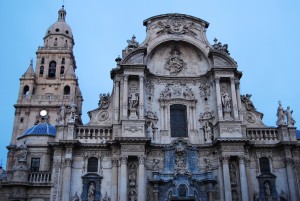Study in Murcia, Spain
Study in Murcia, Spain

Situated between the more-popular beaches of Almería to the south and the crowded resorts of Valencia’s Costa Blanca to the north, the city of Murcia is one of Spain’s most beautiful regions and, surprisingly, one of the least-visited cities in the country. The name “Murcia” derives from the Latin murtae or (mulberry)—a tree that essentially put the city on the map. For centuries, mulberry leaves fed the area’s silkworms, making for a flourishing clothing region that lasted until well after World War II, when local silk could no longer compete against man-made fibers in the textile industry.
The coastline of Murcia, stretching some 250 kilometers in length (155 miles), is appropriately named La Costa Cálida or “the Hot One” due to its warm temperatures. Boasting over 3,000 hours of sunshine each year, visitors to Murcia are almost certain to achieve a full-body tan, whether they decide to lounge in the heavily visited areas of the city such as the Mar Menor, or in the slightly quieter, and much more Spanish-themed resorts to the south.
The well-traveled capital of Murcia, Spain, a region of the same name, is known as a university town with a grand cathedral that has survived the test of time.
Those who plan to visit or relocate to the city of Murcia, Spain will be treated to a number of beautiful sites and attractions—places that include:
Real Casino de Murcia
The Real Casino de Murcia, the city’s magnificent and extremely popular casino, first opened as a gentlemen’s club in 1847. Through the years, the club has been beautifully restored to its original glory, and is now a building that demonstrates a marvelous combination of historical design and opulence, providing a firsthand glimpse of bygone aristocratic grandeur. Beyond the decorative facade of the casino structure are a dazzling Moorish-style patio; a classic English-style library with 20,000 books, some dating from the 17th century; a magnificent ballroom with glittering chandeliers; and a compelling tocador (ladies powder room), complete with a ceiling fresco of cherubs, angels and a surprisingly- winged woman depicted in flames. There is also a neoclassical patio at the repurposed casino, as well as a classic wood-paneled sala de billar (billiards room).
The Cathedral of Murcia
The Cathedral of Murcia, one of the most beautiful structures in the city, was built between the years 1394 and 1465 in the Castilian Gothic style. Its tower was completed in 1792 and demonstrates a blend of unique architectural styles. The first two stories were built in the Renaissance style (1521–1546) that was popular during the period, while the third story is almost completely fashioned in the Baroque style. The bell pavilion of the cathedral shows off both Rococo and Neoclassical influences, while the main façade (1736–1754) is often considered a masterpiece of the Spanish Baroque style.
The Glorieta
The Glorieta, which lies peacefully on the banks of the Segura River, has traditionally been the center of the town of Murcia. The Glorieta is a pleasingly-landscaped city square, and a main gathering spot that was initially constructed during the 18th century. The town’s Ayuntamiento, or “city hall,” is located in the middle of the Glorieta—where the citizens of Murcia can often be found.

